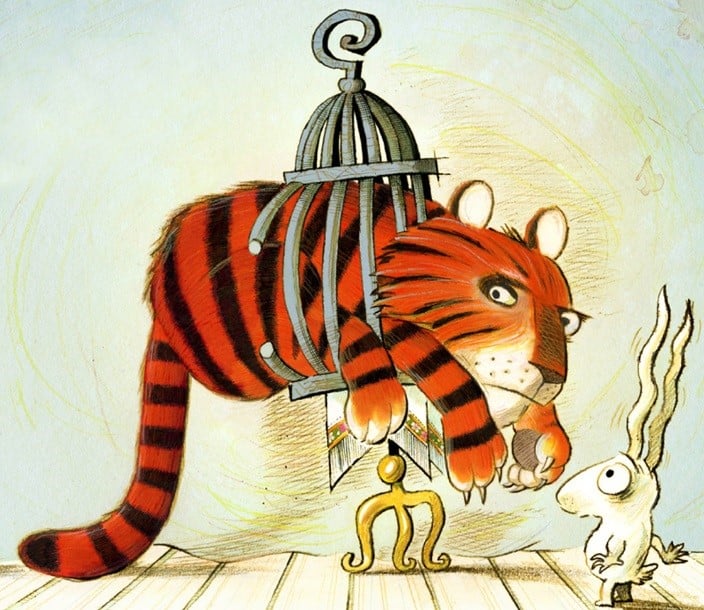Mini Grey is an illustrator and writer of children’s books. Her wonderful book The Adventures of the Dish and the Spoon won the annual Kate Greenaway Medal. Here she talks about her creative processes, what she’s currently working on and offers some tips and advice for budding young illustrators!
What would you say the main themes in your stories are?
I love making unlikely things come to life – so food and toys having adventures seem to be a theme. Also there’s quite a lot of destruction.
Traction Man is Here is used in schools up and down the country and every child I’ve met seems to absolutely adore it! Did you ever expect it to become so popular? Why do you think it’s become so loved by so many?
The thing about Traction Man is he’s only about 20cm high, and most of his adventures happen around the house and garden, and the fun thing is making household objects come to life and take part in his adventures – poisonous dishcloths, wicked spade professors etc. So, maybe it’s something about the transformation of the everyday, and the thing that children do when they pick up an object and start playing with it and bringing it to life.
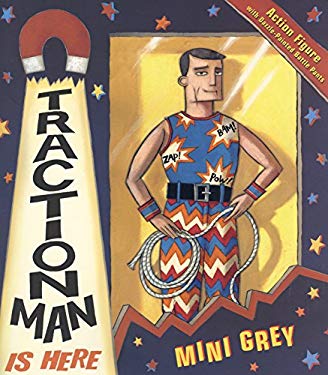
A lot of your stories, like The Pea and the Princess, revisit classic fairy tales. Why is this?
Classic fairy tales and nursery rhymes are familiar territory, we feel like we know the characters. So they’re great material to respond to, to use as a launch pad for a new story, to imagine those characters in new situations.
There has been a lot in the news recently about fairy tales and the negative gender stereotypes they portray. How important is it to you to tackle this in your work?
I try to make female characters active and not too girly. In the Pea and the Princess, the ‘Princess’ (to-be) is really a gardener. Red in The Last Wolf is pretty fearless and practical. But it’s not just gender stereotyping fairy tales are responsible for – it’s species stereotyping too! Fairy Tales REALLY owe wolves an enormous apology for making wolves the blatant baddies over and over again.
I really like the way the reader’s eye is taken across the page in this illustration from The Last Wolf. When you’re writing, do the words come first or the illustrations? How important is the layout of the text and the relationship between the words and artwork?
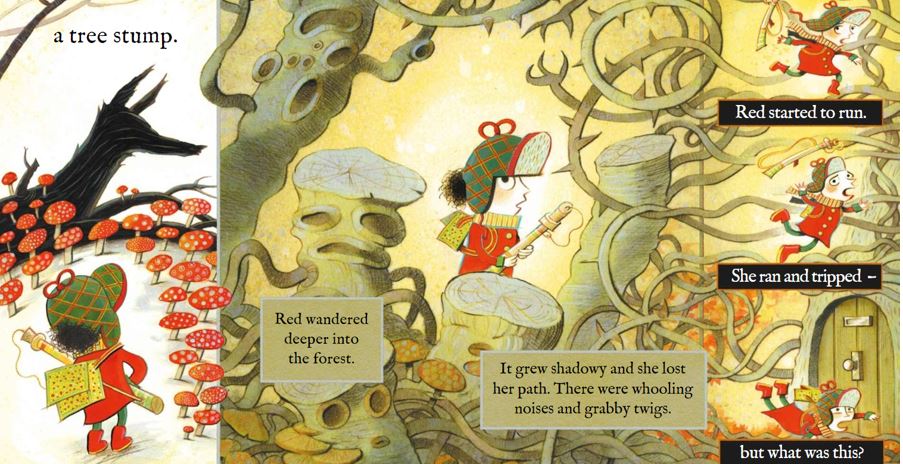
I think with The Last Wolf it started with a sketch of Red and a question like – what if you went out to catch a wolf nowadays? What would happen? So sometimes it’s words, sometimes pictures, but you can respond with one to the other. I like the text to be part of the pictures, and actually punctuate the pictures.
Can you talk to us a bit more about your use of colour in The Last Wolf? There’s lots of beautiful, autumnal reds and oranges. What effect do you think this has? How important is colour to your work? when you’re illustrating, do you try lots of different colour palettes or do you instinctively know what sorts of colours will work for each story?
I wanted the story to start off a bit spring like, and for the seasons to change as Red wanders deeper into the woods, and it to become more and more autumnal until it’s almost winter when we see how little forest is left. There was quite a lot of colour in the sketches right from the beginning, especially the picture of the big tree in the spread after the one above. I try to work out a sort of recipe for how I’m going to make the pictures.
What did you edit out of The Last Wolf?
Why? In my first draft the story started with a view of the original huge forest, and the last spread was going to be a view of what was left of the forest surrounded by houses and roads. But it was too grim an ending and also Red needed to do something, so my editor and I worked out a tree-planting ending.
In The Last Wolf, the animals reminisce about a time when ‘the world was awash with flowers and bees and dripping with honey’. Do you think we’ve lost our connection to nature? Can we get it back?
I don’t know if we have lost our connection with nature – I think people still fiercely love the natural world. But this doesn’t seem to necessarily translate into government policy. Maybe we need politicians with a better connection to nature. What we have lost is a lot of our actual wildlife and their habitats. Since the 1970s more than half of the wild vertebrate animals on Earth have quietly disappeared. And those were the big, visible animals. In a more recent study from Germany, 75% of flying insects – the insects on which everything else depends – were found to have vanished in 25 years. Recent reports on insect numbers are even more dire. The culprits? Habitat loss, pesticides and climate change are all implicated. Protecting wildlife habitat, creating more habitat, and putting habitat-creation at the heart of the planning process should all be our top political priorities. It means not building on wildlife habitat, setting aside no-fishing zones in the sea, and squeezing as much wildlife habitat (like trees!) into our cities as possible. And the bonus is, more wildlife habitat gives us more resilience against climate change, and more comfortable & inspiring places to live.
What do you hope readers will take from The Last Wolf?
More trees please! But also – sometimes you don’t realise what you have lost. Could we learn to co-exist with the larger wildlife we’ve lost in Britain? See Rewilding Britain! https://www.rewildingbritain.org.uk/
I love this double page spread from Toys in Space – it really captures the expanse of the night sky and the toys’ amazement! Can you tell us a little more about this illustration – what you were trying to achieve and how you used colour, perspective and layout to do this?
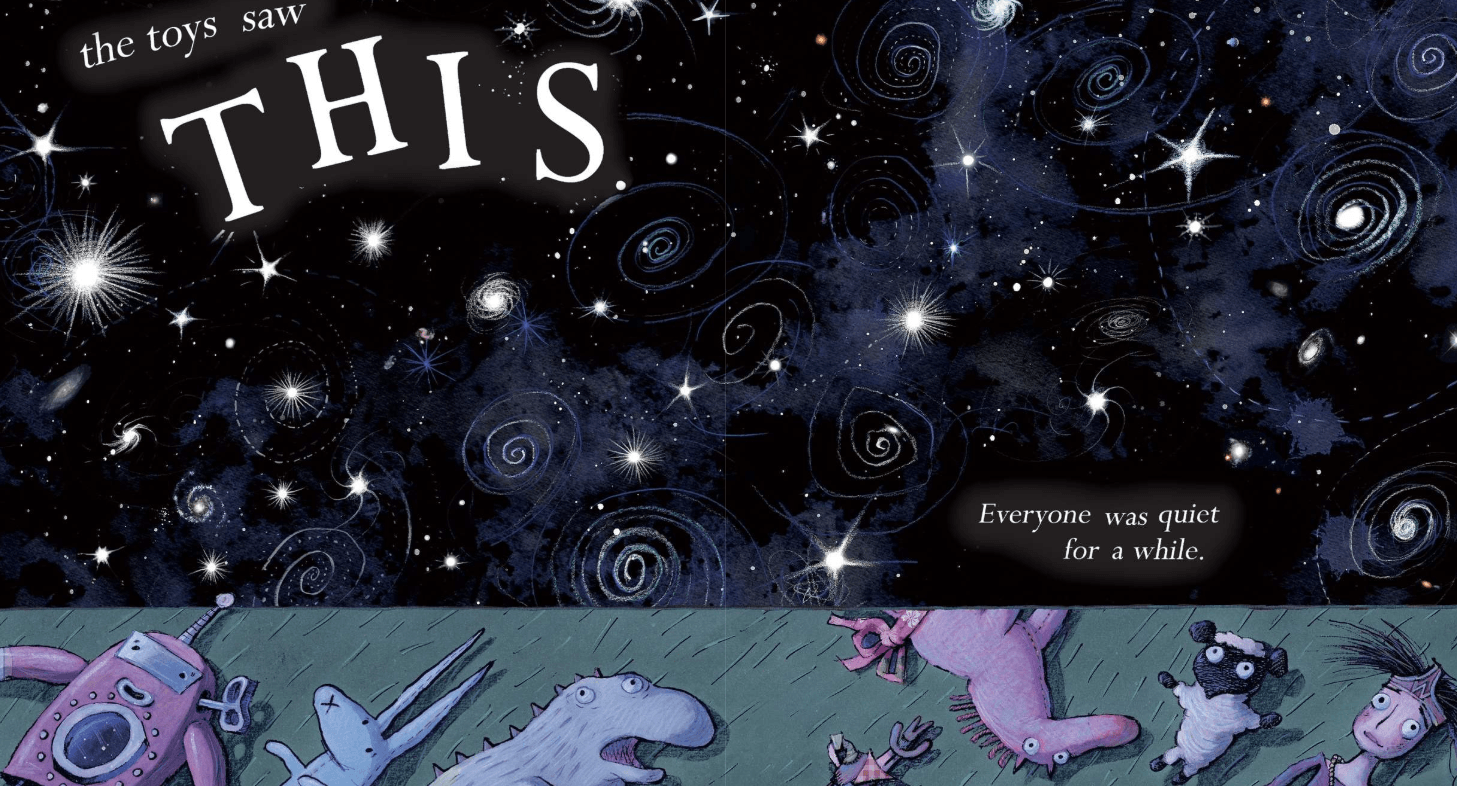
This picture – and the whole story really – came from remembering lying on the grass in places like France and looking up at the night-time stars (probably after a few glasses of vino) and thinking – if you didn’t know what they were, what would you think was going on? Then, I imagined a group of toys left outside overnight in the garden. With this picture, what I wanted was that sense of depth and a million stars and galaxies you get if you look at the sky somewhere truly dark, plus I also needed to show the toys on the ground.
How would you describe your style of artwork? Are there any artists and illustrators who have particularly inspired you?
My artwork is just my best shot at trying to pull out what I was imagining when I was inventing the story. It’s always bitterly disappointing compared with how I was imagining it. I always have an illustrator in mind who I’d rather have make the pictures! I have a big bookshelf full of the work of illustrators I love who are making books today – there are so many brilliant picture makers! My first illustrator-love was for Edmund Dulac, Edward Lear, and Tenniel’s Alice and EH Shepard’s Pooh and Dr Seuss.
A lot of your work has a comic book feel to it, in terms of layout. Would you agree with this? Is this intentional?
It’s usually because I would have wanted more pages and I have to squeeze everything into 32 pages! But also, sometimes you want a page to tell a whole story all in one spread. For example, in Jim there is a Zookeeper interlude. It’s also interesting all the different ways you can section up pages, how the sequencing works – see the work of Winsor McCay for pioneering panel invention…
Has technology changed the way you write and illustrate? If so, how?
When I started making picture books I used to give the finished artwork to my publishers and they’d send it off to be scanned and the designers would put it all together. Now I scan everything myself and often my pages are made of lots of layers I’ve made separately. The downside to this is the artwork to my books might not exist really apart from digitally whereas there used to be a proper picture.
Which character in your books do you think you’re most like and why?
Maybe most like Spoon in the Dish & Spoon, especially my driving skills.
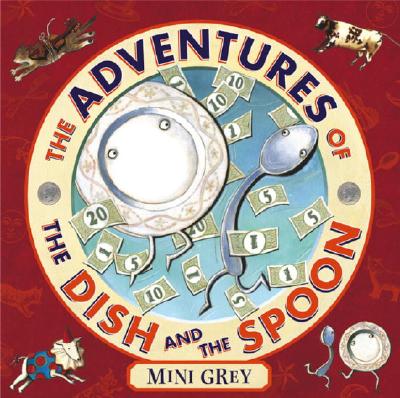
You have a section on your website called ‘Things to make and do’. How important is it to you to interact with your readers? Do you get a lot of work sent to you by your readers?
Nowadays Twitter seems to be a good place for interacting with readers – schools can show me incredible things they’ve been making inspired by my books. I think it’s really important to make things out of real materials and properly make a mess. Materials don’t always behave like you are imagining they will, and this is good for dealing with difficulties and inventing solutions.
What advice would you give to any budding young illustrators?
- Collect ideas and keep a sketchbook: Even if it’s more of a scrapbook. Doodles, scribblings, sketches, sweet wrappers, newspapers clippings – all get stuck into my sketchbook. It’s just really an easier to read way of collecting ideas than a box.
- When in doubt – cut and stick: There’s something liberating and reassuring about being able to move things around. Just cutting out words and arranging them on a page can give you ideas about how that page can work. An open book isn’t flat, it has a fold down the middle, so try planning a spread using a folded-unfolded page.
- Asking a question is often a good way to collect ideas: For example, the very beginning of The Adventures of the Dish and the Spoon was asking the question “What things could a dish and a spoon do together?”
- Use placeholders: If you are stuck for a picture or part of a story, just stick in a label saying ‘This is the bit where so & so happens’ and carry on through. Come back to it later.
- Teeny pictures are faster: Draw something teeny tiny then scan & enlarge & use it to make a new drawing.
- Ignore advice.
Can you tell us anything about what you’re currently working on?
I’ve just finished a book that someone else wrote the words for. It is set in a Wind in the Willows sort of world – so interesting imagining the animals.
Finally, can you describe your books in three words?
Contain Mild Peril….???
This slideshow requires JavaScript.
